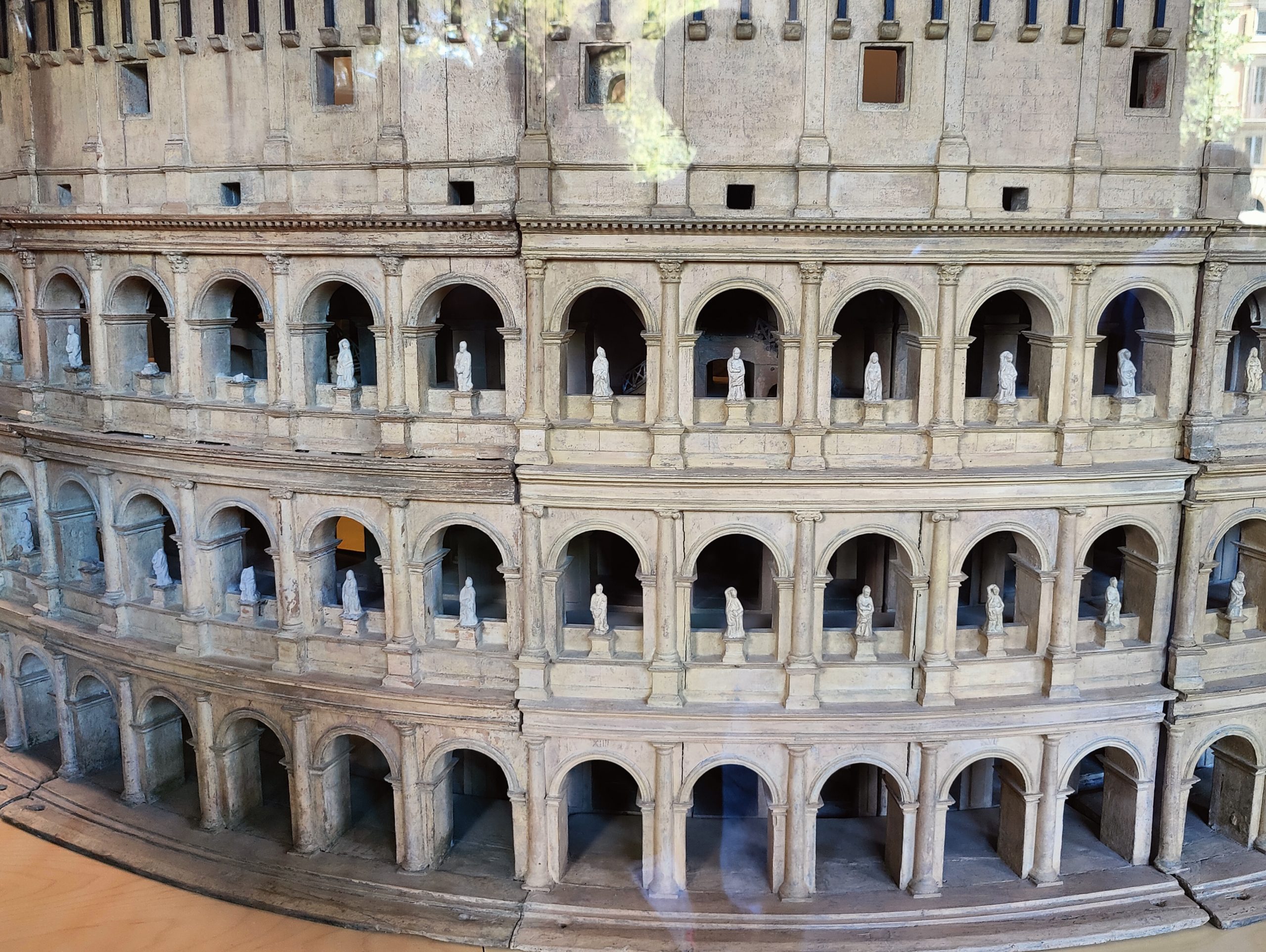The Roman Colosseum is indeed colossal, but that’s not how it got its name.
According to our guide, the emperor Nero chose to have, for the sake of his own self-aggrandizement, an immense statue of himself created, along the lines of the Colossus of Rhodes. The Rhodian statue was, of course, of a god — the sun-god Helios, to be precise — instead of a man; but no matter, because they were deifying emperors faster and faster in those days, and so was Nero not a god too? Of course he was. And so he had a statue built; an enormous gilded monstrosity 96 feet high. Originally, it stood in front of his spectacular golden palace, the Domus Aurea, but it was moved across the road by Nero’s successors and modified into a statue of Helios like the original on which it was based. When construction began, in Vespasian’s time, on a gigantic amphitheater right next door, the theater became known as as the Colosseum, for its proximity to the statue.
We visited the Colosseum late yesterday afternoon, with Carolina again as our guide. There was a bit of initial difficulty in getting there, because we discovered that Italy was having a one-day taxi strike, and there was no way to get where we were going. Eventually, Carolina called her husband, and he brought their personal car around and drove us down. We exited with profuse thanks, and found ourselves at the foot of the Triumphal Arch of Constantine the Great.


The Arch of Constantine was commissioned by the Roman Senate (the only body which could technically authorize a triumph, though in practice by the imperial age, they bestowed them mostly on anybody the emperor wanted them to) to celebrate Constantine’s victory over Maxentius in 312. Or at least that’s the theory. Some scholars think it was actually from the time of Hadrian and only renovated to celebrate Constantine’s victory, but either way, the whole concept is a little controversial… because Maxentius, you see, was the previous Roman emperor. That’s right — the Senate granted a triumph to the current emperor for overthrowing the previous emperor in a coup. No, this is not what triumphs were traditionally for, back in the times of the Roman Republic, but by the imperial age, I am guessing they were too scared not to. Regardless of the reason for it, however, it’s a beautiful structure, with endless detailed carvings all over the stone. There’s a clear difference, however, between some of the earlier carvings which still show the flowing Hellenistic style, in which everyone and everything seems naturally in motion, and the more stilted later style that’s beginning to turn medieval. Because this arch was constructed and reconstructed over a fairly long period of time that spans the transition between the two, both styles are represented in different places on the same arch, and it was fascinating to see the distinctions.
We went on to the Colosseum itself. Also known as the Flavian Amphitheatre, because it was begun by the emperor Vespasian and continued by his sons Titus and Domitian, the three emperors of the Flavian line, the building has been badly treated by the middle ages, but partially restored in the modern day. You can tell easily by the color of the stone which parts are restoration, which is deliberate. They don’t want scholars, or even casual visitors, to be confused about what is genuine ancient Roman and what is modern replica. But the replica does give one a bit of an idea of what it might all have looked like when it was new.
Even though the name didn’t come from the size, the Colosseum is indeed colossal. It could hold 55,000 seats — about the size of the larger modern baseball stadiums — with another 35,000 standing in the upper reaches. As the games provided in the Colosseum were primarily intended as attractions put on by politicians for the citizenry, the seats were reserved for citizens who held the vote those politicians were, even in the age of the emperors, still courting. The standing area was reserved for those who didn’t hold the vote: women, slaves, foreigners or anyone else who didn’t hold Roman citizenship.

There were 80 entrances, 76 of which were used by ordinary people. The rule in case of fire was that you always, always went down the same staircase and out the same door by which you entered. Nobody had to think about it, and so there were no bottlenecks. Reportedly, the entire building could be evacuated in under nine minutes… and since most of it was faced in marble, it was likely much slower than that to burn.
The four special entrances were at the cardinal quarters. The northern entrance was reserved for the emperor and his entourage. The southern entrance was for the magistrates and governmental elite. The eastern and western gates may have been used for elite citizenry as well, but they were also where the gladiators or actors entered for the business of the day, if such were required. Underneath, there was also a way to have parts of the show enter the arena — usually the wildlife, for when participants were set up fight wild beasts. The beasts were sent up by elevator (hauled by hand, with counterweights to help offset the weight) and released from cages as they popped up through the arena floor.
By the time I had absorbed most of the details of how this complex historical entertainment complex operated, the Colosseum was closing for the evening and I had pushed both my feet and my brain as far as they were willing to go. J wanted to go on and see the Forum, and while I was definitely interested, I didn’t feel my legs could take me further. I chose to sit still at the base of the Arch of Constantine, in its convenient shade, and rest while the guide took J to the Forum. He promised to bring me back pictures, and so he did. Here are a few for your own perusal.




Next: leaving Italy for the independent country of the Vatican! We’ll see the Vatican galleries, the Sistine Chapel, and St. Peter’s Basilica.


Leave a Reply